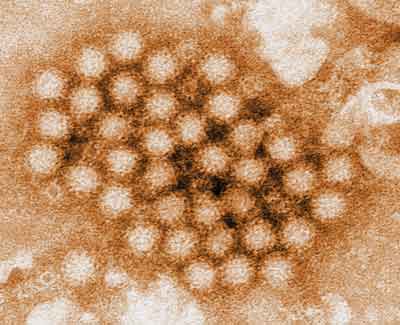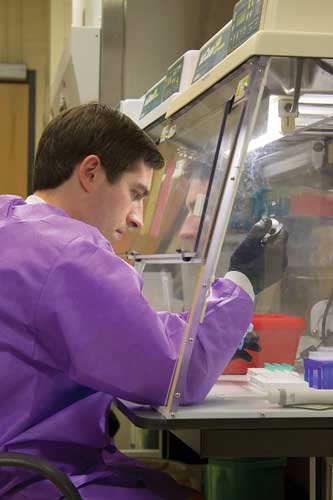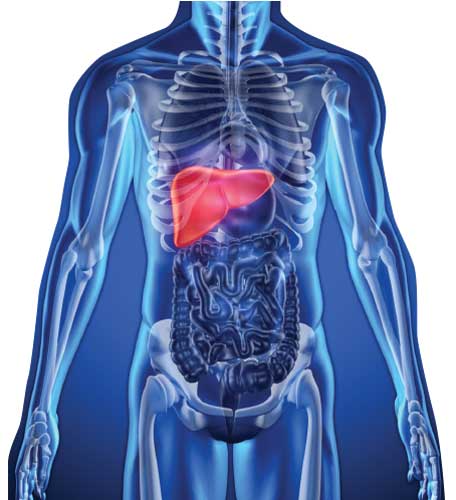Going Viral
FOOD SAFETY & QUALITY
 Although norovirus is the leading cause of foodborne disease, it is not the only virus of concern to the food industry. Norovirus and hepatitis A virus are two of the highly infectious foodborne pathogens that the U.S. Food and Drug Administration (FDA) calls the “big 5”; the others are Salmonella, shiga toxin-producing Escherichia coli, and Shigella species. These five pathogens have a low infectious dose, infect the gastrointestinal system after ingestion, are shed in feces in high numbers, and can readily contaminate food even when appropriate control measures are used.
Although norovirus is the leading cause of foodborne disease, it is not the only virus of concern to the food industry. Norovirus and hepatitis A virus are two of the highly infectious foodborne pathogens that the U.S. Food and Drug Administration (FDA) calls the “big 5”; the others are Salmonella, shiga toxin-producing Escherichia coli, and Shigella species. These five pathogens have a low infectious dose, infect the gastrointestinal system after ingestion, are shed in feces in high numbers, and can readily contaminate food even when appropriate control measures are used.
Norovirus is responsible for about half of all foodborne-disease outbreaks in the United States. Outbreaks on cruise ships gather the most attention, but they account for only about 1% of all reported norovirus outbreaks. The virus is very contagious—most often spread between people in close contact with an infected person. It is commonly transmitted by the fecal-oral route, in which human fecal matter from an infected person comes into contact with foods or beverages, or is deposited on surfaces that are subsequently touched by uninfected individuals, and the virus is subsequently ingested. The virus is also released during vomiting. According to the Centers for Disease Control and Prevention (CDC), 70% of the foodborne norovirus outbreaks in which the source of contamination was identified were associated with infected food handlers.
Theoretically, food can become contaminated with norovirus at any point in the food chain. Epidemiological evidence implicates leafy vegetables, fruits, nuts, and molluscan shellfish as the most common foods involved in norovirus outbreaks. Because food handlers are so important to norovirus transmission, it is generally recognized that ready-to-eat foods subject to significant human handling without a terminal heating step are at greatest risk for contamination.
Hepatitis A virus infects the liver and is highly contagious. It is transmitted by blood-borne routes between people and by the fecal-oral route. Food handlers are the primary source of foodborne hepatitis A virus; most likely to be contaminated are ready-to-eat foods and fruits, vegetables, shellfish, ice, and water. The hepatitis A vaccine was introduced in 1995, and health professionals now routinely vaccinate all children, travelers to certain countries, and persons at risk for the disease. The CDC says that rates of hepatitis A in the United States are the lowest in 40 years.
Update on Norovirus Research
The January 2013 Food Safety & Quality column, “Targeting Norovirus,” presented detailed information on noroviruses and research being funded by the National Institute of Food and Agriculture (NIFA) of the U.S. Dept. of Agriculture (USDA). Among the grants described in the article was a $25-million grant awarded in 2011 to North Carolina State University (NCSU) for a five-year project to study viruses across the food supply chain with a focus on noroviruses. The broad-based project, called the USDA-NIFA Food Virology Collaborative for Outreach, Research & Education (NoroCORE) involves more than 30 scientists from 18 institutions and numerous stakeholders in academia, industry, and government.
The project is now in its fifth year of funding, and NoroCORE’s director, Lee-Ann Jaykus, William Neal Reynolds distinguished professor in the Dept. of Food, Bioprocessing, and Nutrition sciences at NCSU, recently provided an update on what the project has accomplished with regard to its six core functions.
• Molecular Virology. The objectives of this core function are to develop a fully permissive system to cultivate infectious human norovirus, identify and validate the usefulness of alternative cultivatable surrogates, improve understanding of the role of viruses as a cause of foodborne disease of unknown etiology, and develop models to predict human norovirus evolution and strain emergence. Jaykus said that the researchers in the collaborative have been working to cultivate noroviruses and are making progress. In the meantime, they have done a comprehensive comparison of old and new norovirus surrogates that can be grown in culture, including Aichi virus and Tulane virus. Aichi virus is quite resistant, she said, so it is a very conservative surrogate. Tulane is genetically and structurally similar in characteristics to human norovirus and is being increasingly used as a surrogate.
• Detection. The objectives of this core function are to develop simple, practical, and broadly reactive methods to detect human norovirus in clinical samples and in relevant non-clinical sample matrices (food, water, and environmental), compare the efficacy of methods to discriminate between infectious and non-infectious viruses, validate methods, and develop microarray and biosensor platforms for the detection and/or genotyping of human norovirus and other foodborne viruses. Jaykus said that the most pressing detection issue is sample preparation—concentrating and purifying the virus from the sample matrix—and researchers are developing a number of different ligands such as synthetic glycans and antibodies, nucleic acid aptamers, and peptides to facilitate this. Many of the ligands have been evaluated for their ability to interact with different norovirus strains, and so far some of the single-chain antibodies and the aptamers show broad reactivity and are therefore good candidates for developing methods for concentration and detection. Researchers have also developed a very promising low-density DNA microarray for detection and genotyping of both norovirus and hepatitis A virus.
 • Epidemiology and Risk. The objectives of this core function are to develop risk assessment models, estimate the economic burden of foodborne viral disease, and characterize the burden of endemic and epidemic human norovirus illness (with a focus on foodborne transmission), including epidemiological attribution. Jaykus said that studies now show that norovirus is responsible for 25% – 30% of foodborne disease, a little lower than originally thought, and that a very high proportion of those diseases are associated with ready-to-eat foods and/or foods served in foodservice settings such as restaurants, catering facilities, and institutions. Researchers have also shown that a surrogate virus is actually aerosolized during simulated vomiting, providing laboratory evidence that it is likely that norovirus is aerosolized as well. Environmental surveys of restrooms in public places such as restaurants, airports, and airplanes are being conducted. In a small pilot study, no evidence of norovirus contamination was found in environmental swabs from public places, but a large survey of more than 4,000 samples is in progress.
• Epidemiology and Risk. The objectives of this core function are to develop risk assessment models, estimate the economic burden of foodborne viral disease, and characterize the burden of endemic and epidemic human norovirus illness (with a focus on foodborne transmission), including epidemiological attribution. Jaykus said that studies now show that norovirus is responsible for 25% – 30% of foodborne disease, a little lower than originally thought, and that a very high proportion of those diseases are associated with ready-to-eat foods and/or foods served in foodservice settings such as restaurants, catering facilities, and institutions. Researchers have also shown that a surrogate virus is actually aerosolized during simulated vomiting, providing laboratory evidence that it is likely that norovirus is aerosolized as well. Environmental surveys of restrooms in public places such as restaurants, airports, and airplanes are being conducted. In a small pilot study, no evidence of norovirus contamination was found in environmental swabs from public places, but a large survey of more than 4,000 samples is in progress.
• Prevention and Control. The objectives of this core function are to evaluate and monitor virus load pre-and post-harvest, develop and/or evaluate methods to prevent virus contamination in foods, and develop and/or evaluate methods to remove and/or inactivate viruses in foods. Jaykus said that there is evidence for internalization of norovirus by food plants, but very high levels of initial virus contamination are necessary before internalization is actually observed. The exception to this is hydroponic production. She added that a lot of work has been done on alternative methods for inactivating norovirus. The ones that appear most promising from a commercial standpoint are high pressure and pulsed light. Researchers have also shown that copper surfaces have very good anti-norovirus efficacy.
--- PAGE BREAK ---
 • Extension, Outreach, and Engagement. The objectives of this core function are to engage stakeholders and increase appreciation of the role of viruses in foodborne disease, particularly among food safety and public health professionals; evaluate consumer food safety knowledge and refine existing educational resources; field-test food-handler user compliance after exposure to an educational intervention; and provide extension and outreach to the molluscan shellfish and fresh produce industries. Jaykus said that NoroCORE is working very closely with the Interstate Shellfish Sanitation Conference in efforts to establish a new educational curriculum to be delivered to harvesters and receivers. NoroCORE is also preparing editable guidelines for cleanup of vomit and fecal matter that can be used by retail and institutional food sectors. In addition, there is an enormous social media effort going on, she said, running the gamut from blogs to Twitter and Facebook to contests, analysis of social media data, and messaging. NoroCORE is also starting to do some work with the cruise ship industry.
• Extension, Outreach, and Engagement. The objectives of this core function are to engage stakeholders and increase appreciation of the role of viruses in foodborne disease, particularly among food safety and public health professionals; evaluate consumer food safety knowledge and refine existing educational resources; field-test food-handler user compliance after exposure to an educational intervention; and provide extension and outreach to the molluscan shellfish and fresh produce industries. Jaykus said that NoroCORE is working very closely with the Interstate Shellfish Sanitation Conference in efforts to establish a new educational curriculum to be delivered to harvesters and receivers. NoroCORE is also preparing editable guidelines for cleanup of vomit and fecal matter that can be used by retail and institutional food sectors. In addition, there is an enormous social media effort going on, she said, running the gamut from blogs to Twitter and Facebook to contests, analysis of social media data, and messaging. NoroCORE is also starting to do some work with the cruise ship industry.
• Capacity Building. The objectives of this core function are to create a mechanism to foster information and reagent exchange, expand state and local laboratory capacity in food virology, expand professional capacity with a focus on increasing diversity, and develop a graduate-level interdisciplinary curriculum in food virology. Jaykus said that NoroCORE has set up a reagent-exchange system to provide collaborating researchers access to reagents for use in studies; established a searchable, accessible literature database with more than 2,500 journal articles; and sponsored 11 summer interns and 12 graduate fellowships to different institutions in the collaborative.
Jaykus believes that the biggest barrier to future norovirus study and control is obtaining one or more human strains that can be cultivated in vitro. This is a major goal for the NoroCORE group, and progress is being made. Another very important challenge, she said, has been finding a way to inactivate these viruses. Studies are showing that noroviruses are very hardy and many, if not most, of the commonly used inactivation methods do not work well even when used according to manufacturer instructions or regulatory mandates. Another challenge has been providing appropriate education to a varied group of stakeholders, from consumers to public health professionals to the retail food industry. For example, large restaurant chains are well aware of norovirus risks and have staff and programs designed to control disease to the best possible extent, but more than 70% of restaurants are small, and that is a real challenge for them.
New NIFA-Funded Project
NIFA recently funded a project for which the overall goal is to improve food safety by developing novel detection, prevention, and control strategies for human noroviruses and hepatitis A virus. The study, being conducted by Jennifer Cannon, associate professor at the University of Georgia’s Center for Food Safety, began in April 2015 and focuses on developing improved methods for detecting viruses on foods and distinguishing between live infectious virus and nonliving virus, understanding virus survival in healthcare and foodservice settings, and evaluating the efficacy of natural antimicrobials for their ability to kill infectious viruses.
 Among the specific objectives of the study are developing new methods for recovering and detecting human norovirus and hepatitis A virus from food, water, and environmental surfaces; exploring the use of electro-separation using a small pore-sized filter to separate and concentrate foodborne viruses from food matrices; investigating the use of magnetic spheres coated with histo-blood group antigens to concentrate and purify infectious human noroviruses from environmental matrices; investigating the survival of human norovirus and hepatitis A virus on hands and environmental surfaces in healthcare facilities, on dried produce, and in water; exploring differences in norovirus and hepatitis A virus survival on dried produce over time; determining the efficacy of disinfectants used in healthcare facilities for controlling outbreaks of human norovirus; exploring naturally derived liquid antimicrobials effective against human norovirus and hepatitis A virus when used alone or in combination with physical inactivation treatments such as hydrostatic pressure processing or pulsed-light or radio frequency heating; and evaluating the efficacy of chemical treatments that can be used by the healthcare and food industries for inactivating human norovirus and hepatitis A virus.
Among the specific objectives of the study are developing new methods for recovering and detecting human norovirus and hepatitis A virus from food, water, and environmental surfaces; exploring the use of electro-separation using a small pore-sized filter to separate and concentrate foodborne viruses from food matrices; investigating the use of magnetic spheres coated with histo-blood group antigens to concentrate and purify infectious human noroviruses from environmental matrices; investigating the survival of human norovirus and hepatitis A virus on hands and environmental surfaces in healthcare facilities, on dried produce, and in water; exploring differences in norovirus and hepatitis A virus survival on dried produce over time; determining the efficacy of disinfectants used in healthcare facilities for controlling outbreaks of human norovirus; exploring naturally derived liquid antimicrobials effective against human norovirus and hepatitis A virus when used alone or in combination with physical inactivation treatments such as hydrostatic pressure processing or pulsed-light or radio frequency heating; and evaluating the efficacy of chemical treatments that can be used by the healthcare and food industries for inactivating human norovirus and hepatitis A virus.
Recent University Research on Viruses
Researchers at various universities presented papers on viruses at the 2015 IFT annual meeting.
• University of Tennessee. Doris H. D’Souza, Snehal S. Joshi, and Amy B. Howell studied the effect of blueberry proanthocyanidins in model food systems (apple juice and 2% reduced-fat milk) and simulated gastrointestinal fluids against human norovirus surrogates, feline calicivirus, and murine norovirus. The researchers reported that the proanthocyanidins decreased human norovirus titers in the model food systems with less effect in milk but said that studies with encapsulated blueberry proanthocyanidins are needed for antiviral application purposes.
Andres Arreaza and Doris H. D’Souza compared the effectiveness of four chemicals on inactivation of Aichi virus, an emerging global foodborne virus causing acute gastroenteritis for which there is no vaccine and limited literature on control measures. The researchers said that sodium hypochlorite and potassium peroxymonosulfate rapidly inactivated the virus in suspension while slow-acting tribasic sodium phosphate and benzalkonium chloride were less effective.
Snigdha Sewlikar, Doris H. D’Souza, and Amy B. Howell studied the effect of cranberry juice and cranberry proanthocyanidins, which are effective against human norovirus, on inactivation of Aichi virus. The researchers said that cranberry juice and cranberry proanthocyanidins show promise as natural antivirals against Aichi virus in vitro but further studies with model food systems and simulated gastric conditions are needed.
Snehal S. Joshi and Doris H. D’Souza studied the use of grape seed extract, which has known antibacterial properties, for inactivation of Aichi virus, for which traditional inactivation methods including chlorine, ethanol, and high-pressure treatments are not very effective. The virus was aseptically inoculated onto sterile stainless-steel coupons and allowed to air-dry, then treated with grape seed extract. The researchers said that the extract rapidly inactivated the virus, indicating that it shows promise as a surface wash for use in hurdle approaches against the virus.
--- PAGE BREAK ---
Hayriye Bozkurt Cekmer, P. Michael Davidson, and Doris H. D’Souza investigated the effect of heat transfer with different container sizes on the thermal inactivation kinetic parameters of hepatitis A virus in buffered cell-culture medium. The researchers said that the resulting proposed numerical solution could be used for predicting the thermal inactivation behavior of enteric viruses in foods with different container sizes and could contribute to the development of appropriate thermal processing conditions for foodborne enteric viruses to ensure safe food for human consumption.
Doris H. D’Souza and Andres Arreaza studied the ability of sodium metasilicate and calcium hypochlorite to inactivate Aichi virus. The researchers reported that calcium hypochlorite was more effective than sodium metasilicate for the reduction of the virus under dried conditions but longer contact times and higher concentrations of both chemicals are needed for effective control under simulated dirty conditions and in real-world scenarios.
• University of Delaware. Chuhan Liu, Xinhui Li, and Haiqiang Chen studied the effect of ultraviolet light (UV) alone and in combination with chlorine to inactivate murine norovirus on fresh blueberries, both dry and immersed in agitated water. The researchers reported that a combination of UV and chlorine treatment had better or similar inactivation efficiency as water-assisted UV and chlorine wash alone and concluded that UV treatment could be used as an alternative to chlorine wash for blueberries and potentially other fresh produce.
Mu Ye and Haiqiang Chen developed a porcine gastric mucin binding method as a surrogate assay for virus infectivity and used it in pulsed-light, UV light, and chemical inactivation studies using Tulane virus. The researchers concluded that the binding assay could roughly reflect the infectivity of Tulane virus after chlorine and ethanol treatments and could be potentially used as a means to quantitate inactivation of human norovirus.
Runze Huang, Xinhui Li, and Haiqiang Chen studied the effect of high-hydrostatic pressure (HHP) on inactivation of human norovirus on berries, using porcine gastric mucin-conjugated magnetic beads and real-time reverse transcriptional polymerase chain reaction. The researchers concluded that HHP is a suitable nonthermal intervention for human norovirus in strawberry, blueberry, and raspberry purees and on blueberries.
Yaoxin Huang, Xinang Cao, Haiqiang Chen, and Mu Ye evaluated the inactivation by pulsed light of two human norovirus surrogates, murine norovirus and Tulane virus, as well as Escherichia coli O157:H7 and Salmonella, on berries. The researchers concluded that pulsed light can induce rapid inactivation of both viruses and bacteria in clear suspension, the surrogates are more resistant than the bacteria, and treatment efficacy is significantly influenced by the surface structure of the food.
• Yonsei University. Soyoung Chun, Sun-Hyoung Kim, Daseul Park, and Jiyong Park evaluated the inactivation effect of titanium dioxide (TiO2)—a photocatalyst that generates hydroxyl radicals having germicidal power under UV irradiation—on murine norovirus as a surrogate for human norovirus. The researchers used three different wavelengths of UV light and reported that murine norovirus was quite resistant to UV at 352 nm, suggesting that TiO2 could be useful for disinfection at this wavelength.
Daseul Park, Sun-Hyoung Kim, So Young Chun, and Jiyong Park said that HHP has been used as a potential method to control human norovirus in fresh foods but that disinfection of foods is inconsistent because of variations in contamination levels and morphological characteristics. The researchers developed a Bacto agar solid model to simulate foods, studied the effect of HHP on inactivation of murine norovirus, and concluded that HHP above 500 MPa can be used as a promising technique to eliminate foodborne viruses in fresh foods.
• University of Maine. David F. Bridges, Anna Breard, Alison Lacombe, Don C. Valentine, Shravani Tadepalli, and Vivian C. Wu studied the antiviral properties of five components extracted from low-bush blueberries against Tulane virus. The researchers concluded that reduction of the virus to undetectable levels by total blueberry extract coupled with the significant reduction found in the other fractions indicates great promise for further research promoting their use as antiviral agents against human norovirus and other viruses.
• Illinois Institute of Technology. Ji-Young Shim, Diana Stewart, Alex Nikolov, Darsh Wasan, Rong Wang, and Y. Carol Shieh used atomic force microscopy to study the adhesion forces of a virus surrogate, MS2 coliphage, on two common food processing and preparation surfaces, polyvinyl chloride (PVC) and glass. The researchers reported that the virus had lower adhesion to glass than to PVC and that adhesion to PVC could be significantly weakened by incorporating a surfactant such as sodium dodecyl sulfate, thus providing a potential means of enhancing viral pathogen removal from these food-contact surfaces.
• Chung-Ang University. Researchers Shin Young Park, Myeong-In Jeong, Sujin Kang, and Sang-Do Ha studied the effects of soy sauce containing different concentrations of sodium chloride on the survival of murine norovirus, a surrogate for human norovirus, and hepatitis A virus in experimentally contaminated Ganjanggejang (the Korean traditional preserved raw crab product) during storage. The researchers concluded that soy sauce containing 20% or more sodium chloride, or 10% – 20% sodium chloride with longer storage times, could have a more complete inactivation of both murine norovirus and hepatitis A virus.
• University of Arkansas. Ronghui Wang, Lijun Wang, and Yanbin Li described development of a quartz crystal microbalance aptasensor with nanoporous gold film modified electrode for rapid, sensitive, and label-free detection of the highly pathogenic H5N1 avian influenza virus. The researchers concluded that the aptasensor could dramatically reduce detection time and could be adapted for detection of other viruses and that further research will focus on optimization of this system for detection of the virus in poultry swab samples.
 Neil H. Mermelstein, IFT Fellow,
Neil H. Mermelstein, IFT Fellow,
Editor Emeritus of Food Technology
[email protected]


